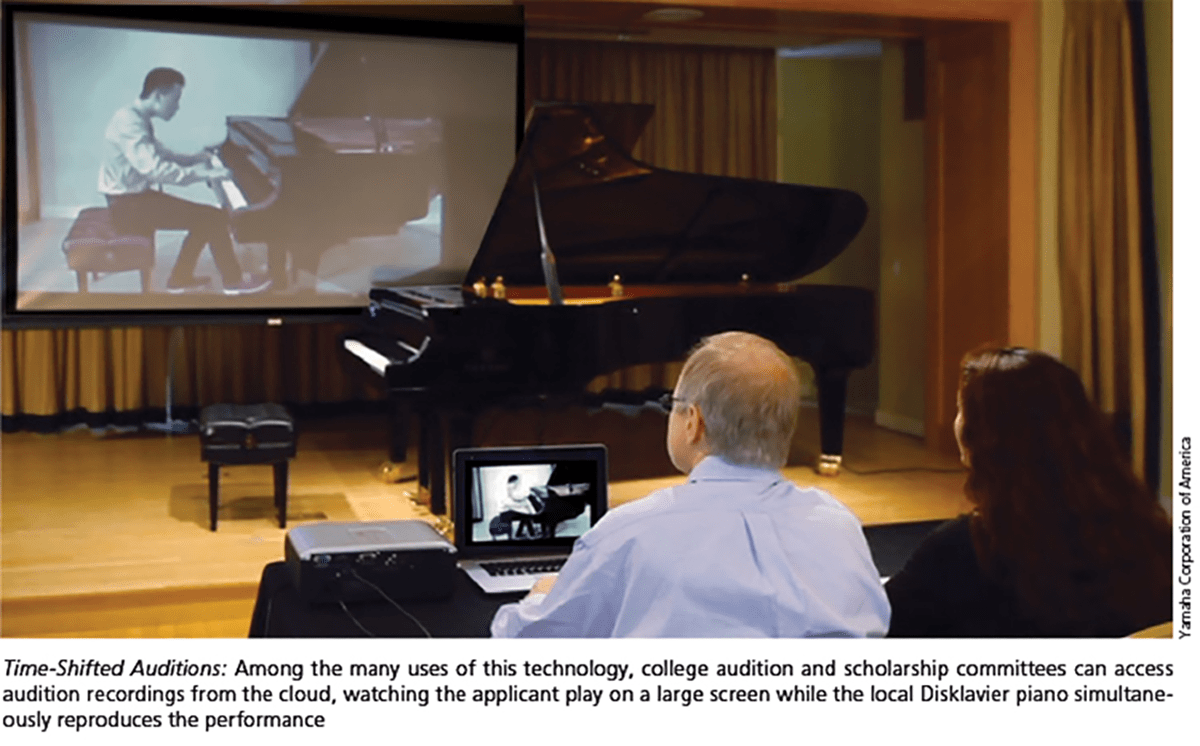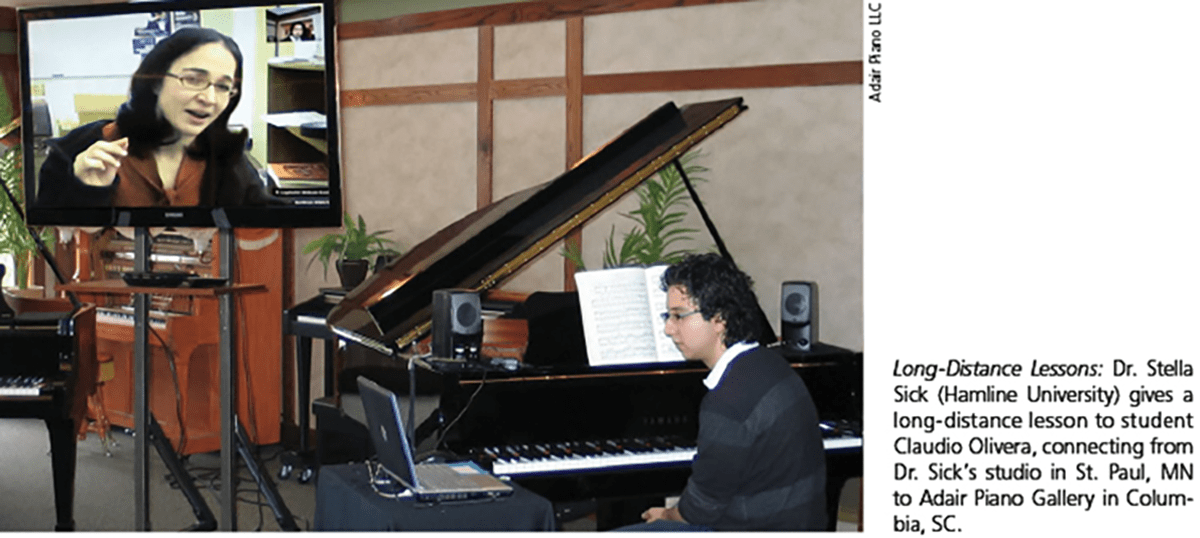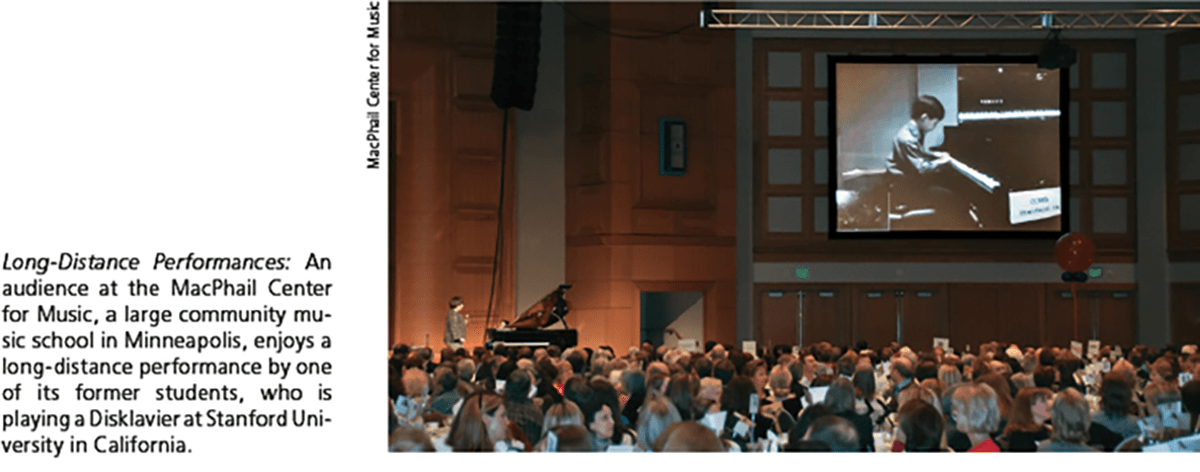
Each instrument was connected to a laptop computer running a software program called Internet MIDI. As I played, every one of my keystrokes and pedal movements was faithfully transmitted to and reproduced on the other piano. As the remote audience watched me on a big screen, they heard me play the Denver piano as if I were in the same location, seated on the bench.
In the 21st century, this is as close as we can get to the concept of "beaming ourselves" from one location to another.
300+ Years of Technological Change and Innovation
Sometime around 1700, Bartolomeo Cristofori di Francesco, an Italian instrument maker, invented the keyboard escapement action. That invention, generally considered to mark the beginning of the piano, was just the first in a long line of innovations that have provided us with the modern, technology-equipped piano that we enjoy today.
Most of the innovations in piano design of the last 300 years were the results of interactions between composers, performers, and instrument makers, each group making demands on the other groups as well as responding to their innovations.
Consider, for example, the knee lever, which was introduced in the 1760s to lift the dampers off the strings. This allowed composers to assume that an instrument could have a sustained, singing tone, and thus influenced the development of a new cantabile style of writing and performing.
Within a couple of decades, the knee lever began to be replaced by what we now call the sustain pedal. This invention had an even more profound influence on composers and performers. Can you imagine the severe limits within which Frédéric Chopin would have had to compose had pianists of his era been constrained by the cumbersome operation of knee levers?
Innovations of Our Era
One of the most obvious piano innovations of the last four decades has been the introduction and development of solenoid-based record-and-playback systems. These systems have been available as factory-installed features on pianos made by Bösendorfer, Mason & Hamlin, Story & Clark, and Yamaha, and as retrofits for almost any other new or used instrument.
Over the last 25 years, such systems have become very popular as entertainment devices in homes, hotels, and restaurants. Data from the piano industry suggests that the playback feature has created a new class of piano buyer: individuals who don't play the piano themselves, and who otherwise would not have considered buying a piano.
Despite the reputation that these instruments have acquired as entertainment devices, innumerable applications have been developed by music educators and performing musicians that take advantage of the technologies embedded within them, including:
- interactive software for piano instruction
- accompaniments for singers, instrumentalists, and dancers
- multimedia performance
- long-distance teaching and performing
- composition
- screening auditions for competitions, scholarships, and college admissions
The Technology-Equipped Pianos of Our Era
Before delving into the professional and educational applications listed above, we should examine the concept of the technology-equipped piano and look carefully at the various components that such a piano may include. Few of these technical components have a single purpose; most can be mixed and matched in a variety of ways to serve a multiplicity of needs.
A technology-equipped piano may include any combination of the following:
Recording System + MIDI Output
Recording systems generally store performance data (i.e., key, hammer, and pedal movements) as Standard MIDI Files. As you play the instrument, the recording system can also send the data in real time to external devices, such as computers, tablets, and other keyboard instruments.
Real-time MIDI output makes possible a variety of opportunities for teachers, students, and performers, including long-distance lessons and performances, concerto practice with a virtual orchestra that follows your playing, multimedia performance, and more.
Playback System + MIDI Input
Playback systems are capable of reading recorded MIDI data and reproducing the original performance. These same systems can also respond to incoming, real-time MIDI data from external devices such as computers, tablets, tone generators, and other keyboard instruments.
The ability to respond to incoming MIDI data is a necessary component for long-distance teaching, as well as for receiving real-time MIDI streams from live performances taking place elsewhere in the world.
Tone Generator
Most technology-equipped pianos have a split personality: they are both an acoustic piano and an electronic tone generator. The electronic tone generator enables the instrument to play multitrack MIDI files, which contain data that drive the piano itself, as well as data that produce other instrumental sounds resident in the tone generator.
In most cases, a performer can access the tone generator in real time, layering other instrumental or synthesized sounds on top of his/her playing of the acoustic piano, thus facilitating various contemporary styles of live performance.
Silent Feature
In recent years, one of the remarkable enhancements of the piano escapement action has been the silent feature. When this is engaged, a hammer stop rail is moved into place to prevent the hammers from hitting the strings. An obvious application of this feature is quiet practice; just put on headphones, and you’ll hear yourself as if you were playing a digital piano.
This silent feature also enables a pianist to become a substitute harpsichordist, vibraphonist, or organist. If you connect the piano’s built-in tone generator to external speakers and engage the silent feature, the audience will no longer hear a piano sound but, instead, an instrumental voice produced by the tone generator.
Microphone-Free Recording
A piano with a silent system may have an excellent digital piano sample that resides in the tone generator (i.e., the sound that you hear when you’re playing with headphones on). In some cases, that tone generator can be used to convert recorded MIDI data to a 16-bit/44.1kHz audio recording. Imagine making a studio-quality recording without microphones, mixers, and recording engineers!
Network Connectivity
Many technology-equipped pianos now have a network-connectivity feature that enables the piano to be connected both to a local area network (LAN) and to the Internet. This feature can serve multiple purposes.
For example, you can install a mobile app in your smartphone or tablet, and use your mobile device to access the piano’s features wirelessly. Alternatively, the network feature may provide Internet connectivity for downloading recorded performances, or even receiving performances streamed to the piano in real time. Imagine listening to a live concert played on your piano, or accessing a performance from an on-demand library.
Internet connectivity may also enable a direct connection between your piano and another piano elsewhere in the world. When you play a note or press a pedal on your piano, you simultaneously move the same key or pedal on the remote instrument. When combined with a video-conferencing program such as Skype, this capability enables long-distance lessons.
Educational and Professional Applications
The features listed above can be mixed and matched in a number of ways limited only by your creative imagination. And once you bring interactive computer software into the picture, just about anything is possible.
Consider some of the following examples:
Time-Shifted Auditions
In 2013, Yamaha announced the Disklavier Education Network (DEN), and established a presence for the DEN at www.YamahaDEN.com. One of the DEN's first projects was to offer prospective college piano majors the opportunity to audition for multiple schools with a single audition program, recorded on a Disklavier with synchronized video. Participating colleges and universities were required to have a Disklavier PRO piano for playback.
Audition sites were initially set up in 27 locations in the United States and Canada, including locations as remote as Hawaii and the Aleutian Islands. Students scheduled a time to record their audition program on a Disklavier, including synchronized video, and their recordings were uploaded to the cloud for later access and playback.
The audition and scholarship committees at participating schools subsequently scheduled a convenient time to access these recordings. In a typical setup, the student's video was projected onto a large screen while the local Disklavier simultaneously reproduced each recorded audition.
The DEN's audition program is significant because many school music programs require an audition as part of the admission process, or to determine scholarship awards. For a high-school senior traveling with a parent, or even a graduate student traveling alone, traversing the country auditioning for multiple schools can be a very expensive proposition. Imagine the cost for a student living in Vermont to travel to Texas for an admission audition, and then to Oregon for a scholarship audition. The DEN program makes it possible to audition once, on a Disklavier, and to have that audition used in many locations without incurring additional travel expenses. The video-sync technology of the Disklavier provides a performance opportunity that is nearly the same as an in-person audition.

The concept behind the DEN's audition program was pioneered in 2003, by the International Piano-e-Competition (www.piano-e-competition.com). To provide audition opportunities for the largest number of contestants, the competition set up virtual auditions with Disklaviers at various locations around the world. Later, a screening jury met for several days, watching each contestant on a 10' screen while listening to their time-shifted auditions reproduced on a 9' Disklavier in a concert hall at Hamline University, in Saint Paul, Minnesota.
Streaming Concerts
The real-time equivalent of the virtual audition idea is the live streaming of a concert performance to multiple locations. Yamaha has pioneered a technology, RemoteLive™, that makes it possible to stream video, audio, and MIDI data for both solo piano and ensemble performances. In the summer of 2014, for example, the finals of the Piano-e-Competition will be streamed using this technology, and will be available through a Yamaha service called DisklavierTV™.
Educators have begun using live streaming to broadcast lecture recitals. DisklavierTV offers the capability of archiving these broadcasts for subsequent viewing on demand.
Contemporary Piano Pedagogy
The record and playback features of technology-equipped pianos are at the heart of most pedagogical applications. Student pianists are challenged to listen to themselves critically when they play. When their teacher records them on a quality reproducing piano, the teacher can provide the student with the opportunity to listen to the performance from the audience's perspective.
How steady was the tempo? Was the pedaling clean? Was the melody projected beautifully over the accompaniment?
After listening to themselves and determining precisely what they need to work on, students typically return to the piano with a new sense of musical purpose and determination that focuses their subsequent practice.
Pedagogical applications don't begin and end with recording and playback. The embedded General MIDI tone generators available in most reproducing pianos offer additional teaching opportunities.
Since the early 1990s, most publishers of piano teaching materials have also offered MIDI accompaniments that coordinate with the pieces in the method and supplementary books. Originally, these MIDI accompaniments were offered on floppy disk. Today, many companies offer them as files that can be copied from CD-ROM or downloaded from the Internet.
These MIDI accompaniments typically provide steady backing tracks that can be played at any tempo without audio degradation. In effect, they have become a modern replacement for the traditional metronome. In the case of teenage and adult beginners, they have proven especially effective because of their ability to create a complete musical experience that can surround an otherwise very simple piano part.
Although these MIDI accompaniments can be used effectively in traditional teaching, they have provided the basis for an entirely new category of music instruction known as recreational music-making (RMM). RMM programs typically reach out to busy adults, senior citizens, and students with physical or mental handicaps; they provide these constituencies with the opportunity for meaningful music-making that doesn't require the rigor of years of practice.

Interactivity with Computers and Mobile Devices
A number of interactive software applications were developed for pianists and piano students in the 1990s. At the time, computers tended to be large and awkward to use in conjunction with a piano. In the early 2000s, laptop computers became more affordable and common, yet many pianists didn't care for the look of a laptop sitting atop a piano.
Now that we've entered the era of mobile computing devices, tablets are gaining acceptance as a logical replacement for a paper book that sits on the music desk.
The iPad, in particular, has good support for MIDI input and output, making it a compelling device to use with a technology-equipped piano. Applications range from score-viewers whose pages can be turned by the press of the (normally unused) middle pedal, to instructional software that responds to your playing, to music games that challenge the student to play notes accurately.
On a more professional level, laptop computers provide more processing power than a tablet, and can be used to provide a virtual orchestral accompaniment that actually follows the tempo set by the performer. The instrument's MIDI output can even be used to control a computer slide show, or drive a multimedia display during a concert performance.
Traditional and Interactive Music Composition
A piano is an essential tool for any composer who wants to try out musical ideas quickly. The MIDI features of a technology-equipped piano make it possible to enter notes directly into a music-notation program by playing on the piano itself. Just press the keys and watch the notes pop up on the musical staff.
A growing number of composers, such as Chris Dobrian (University of California–Irvine) and Tod Machover (MIT), have taken the concept of MIDI connectivity a big step further, composing works that involve interaction with a computer in real time. In these scenarios, a software program typically reacts to MIDI data generated by the performer and sends MIDI data back to the piano, effectively improvising along with the pianist in a semiplanned, algorithmic way.
Ever-Ready Accompanist
Over the years, many colleges and universities have purchased Disklaviers for the purpose of providing piano accompaniment for singers, instrumentalists, and even dancers. The idea has generally not been to replace the human performer, but to provide students with an ever-ready practice partner that is willing to play any portion of a piece, over and over, at any time and in any key or tempo. Students accompanied in this way are generally much better prepared for the moment when they work with a live pianist.
It's exciting to think that Cristofori's masterpiece continues to evolve and keep pace with the times, while the concept of what it means to play a piano extends into unprecedented territory.